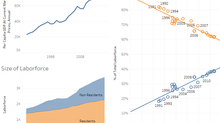Singapore in Numbers - Social Class?
Recent study suggest a growing class divide in Singapore
People like to associate and mingle with people like themselves, that has been true across most societies. And
in multiracial and multicultural Singapore, race and religion had been Singapore’s historical dimensions for social divide.
However, a recent study (Dec 2017) by The Institute of Policy Studies (IPS) of the social networks of over 3,000 Singaporeans and PRs suggests that Singapore society now identified themselves more along social status, rather than religion and race.
The study showed that Singaporeans tended to socialize largely within their own social class as defined by their:
Housing type – private property dwellers vs public housing dwellers; and/or
The school that they came from – “elite” school vs non-“elite” school
Though the social networks for those in private housing and from elite schools showed more diversity than those from public housing and non-“elite” schools; that is, a large majority of social networks of Singaporeans living in public housing and/or from non-“elite” schools were exclusively in their own social class.
While thought provoking; the findings from this study cannot be considered in a vacuum by itself. And from an objective standpoint, it also prompts new questions that some may not think to consider; such as:
The study’s the underlying assumption is that people living in private housing and/or come from “elite” schools are from the higher social class. How true is that?
How different are the lifestyles between private and public housing, and between elite and non elite school alumni?
The study alluded to the fact that Singapore was divided by race and/or religion in the past; but no such data was presented nor was there any available comparison of a similar survey from the past
If the findings are indeed true that Singapore is now stratified by social class, what are the potential implications to Singapore?
Perhaps the following lesser known facts and data might shed some new light...

Did you know...
Higher income households tend to live in private property
60% of the top income decile households live in private property and progressive falls in lower income deciles
Private property is not exclusive to high income households
38.9% of the top income decile residents live in public housing; and some proportion of even the lowest income deciles residents live in private properties
On average, private housing dwellers have twice or more income per person per month compared to those living in public housing
This is consistent regardless landed properties or condominiums
While the quantum has grown, the ratio has also been relatively consistent over time
Sizeable proportion of students who come from “elite” schools tended to be living in private property and/or have a monthly household income of more than $10,000
Singapore Median household income from work in 2016 was only $8,816
60% of PSC scholars come from only 2 schools – Raffles and Hwa Chong
While Singapore’s measure of income inequality (GINI Coefficient) is the lowest it has been in the last ten years
It remains one of the highest among developed nations (OECD); Only Hong Kong’s GINI coefficient remains much higher
Key observations and considerations
The key dimensions to IPS’ study appear to be valid
Higher income social class tend to come from “elite” schools; and the higher income social class also tend to live in private property. However, private housing and “elite” school are not exclusive to the high income social class
The higher income social class have significantly more resources to deploy per household member; twice or more as compared with those living in public housing
The higher income social class also appear to have greater access to education, development and other opportunities in Singapore
The IPS survey show that the lower income social class appears to keep more to themselves.
In the context of Singapore’s highly competitive (“kiasu”) culture and social comparison theory, the “upper” class may not mind socializing with the “lower” as it makes them feel better about themselves; while the “lower” class may prefer not to socialize with the “upper” class as it makes them feel worse about themselves
Despite recent efforts, Singapore’s income inequality remains high
Against this backdrop, the data does appear to support the idea that Singapore is now more distinctly stratified by social class. And as in any society the upper class have more resources and greater access to opportunities. The IPS study could also suggest that a growing resignation of one’s social class and the perception that social mobility is less attainable; which could breed division and resentment across classes. Potentially a situation of “US vs “THEM”. In the wake of the Occupy movement against social and economic inequality that spread across 951 cities across 82 countries and 600 communities across the United States in 2011 we have seen the possible consequences that could await Singapore if this divide grows too wide to overcome. Consider also, that Singapore being one of the most expensive cities to live in and while income inequality has fallen, Singapore’s GINI coefficient remains one of the highest among developed nations. While not alarming at this point in time, this is certainly a societal fault line that policy makers should pay close attention to.


























